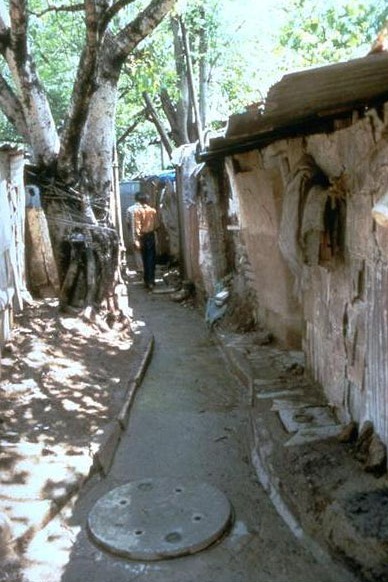Urban sanitation − lessons
from experience (Waterlines, 2008) − excellent review
of
community-based sewerage in South Asia
"SLUM NETWORKING" IN INDIA (see photo at bottom of page)
Water and
Sanitation: The Quickest Route to Prosperity ['Slum networking'] (RSA, 2005)
Slum Networking: An Innovative Approach to Urban Development
in India
(BSHF, 1997)
Slum Networking of Indore City (pages 54−65 of Legacies for the Future: Contemporary
Architecture in Islamic Societies, Thames and Hudson, 1998)
Additional details and down-
loadable files here.
Engineering as a tool for
improving human habitat (Int. J. Management and Decision Making,
2009) – Quote: The
concept of Slum Networking proposes comprehensive water
and environmental
sanitation infrastructure as the central and catalytic
leverage for holistic
development. At costs less than the conventional ‘slum’
solutions, it tries to
penetrate a high quality urban infrastructure net deeply
into the slums to
assimilate them into the city rather than lock them in as
disadvantaged
islands.
Ahmedabad
Parivarten (WSP, 1997)
Slum Networking - A Holistic
Approach for Improvement of Urban Infrastructure
Environment (AIT, 1999)
Slum networking: changing
settlements from within (changemakers.net, 2006)
Sustainable infrastructure development for slums and villages (WEDC, 2002)
The Orangi Pilot Project (OPP), Pakistan
OPP's homepage
From the Lane to the City: The Impact of the Orangi PP's Low
Cost Sanitation Model
(WaterAid, 2001)
Orangi Pilot Project: the expansion of work beyond Orangi
and the mapping of informal
settlements and infrastructure (
E&U,
2006)
The Orangi Pilot Project, Pakistan (iied, 1996)
Community-driven Water and Sanitation: The work of the
Anjuman Samaji Behmood and the
larger Faisalabad
context, Pakistan
(iied, 2001)
Video (in Microsoft Producer
format): Return of the Drain Gang (low-cost sewerage in
Faisalabad,
Pakistan) (download zip file
here)
Urban Sewer Planning in Developing Countries and the
"Neighbourhood Deal" (WSP, 1997)
Of
the People, by the People, for the People:
Community-based Sewer Systems in Melang,
Indonesia (WSP,
2000)
Sanitation by the Community in Denpasar, Indonesia
[SANIMAS] (UNESCAP, undated −
probably 2006)
Appropriate
Design Standards and Construction Specifications for Tertiary Sewerage Systems
[Faisalabad,
Pakistan] (GHK,
2002) −
in this publication settled sewerage is
recommended:
“Solids traps and interceptor tanks on household connections
are therefore an
integral component of the recommended design for tertiary
sewerage systems”
(pdf page 28) − interceptor tank design is given on pdf
pages 41−43.
See also: Low-cost combined sewerage
Simplified sewerage in India
Simplified Sewerage
– An appropriate option for rapid sanitation coverage in urban areas
(Foundation for Greentech Environmental
Systems, 2008) − reported costs are one third
of those for conventional sewerage.
Note: simplified and settled sewerage are at least mentioned in the Indian
Sewerage and Sewage Treatment Manual (2nd ed., Ministry of Urban Develop-
ment, New Delhi, 1993): details here.
 Slum networking in India: a sewered lane
Slum networking in India: a sewered lane
